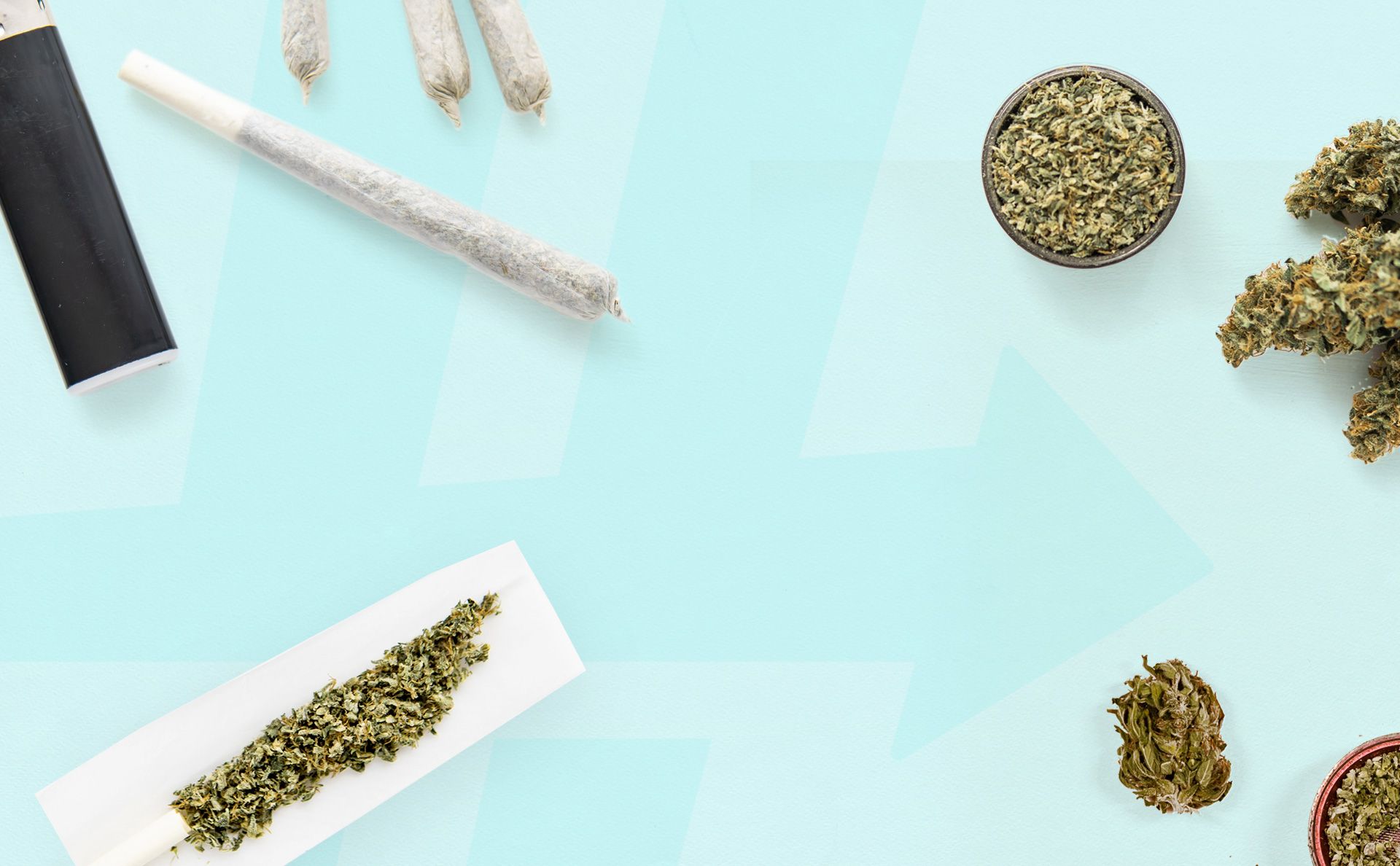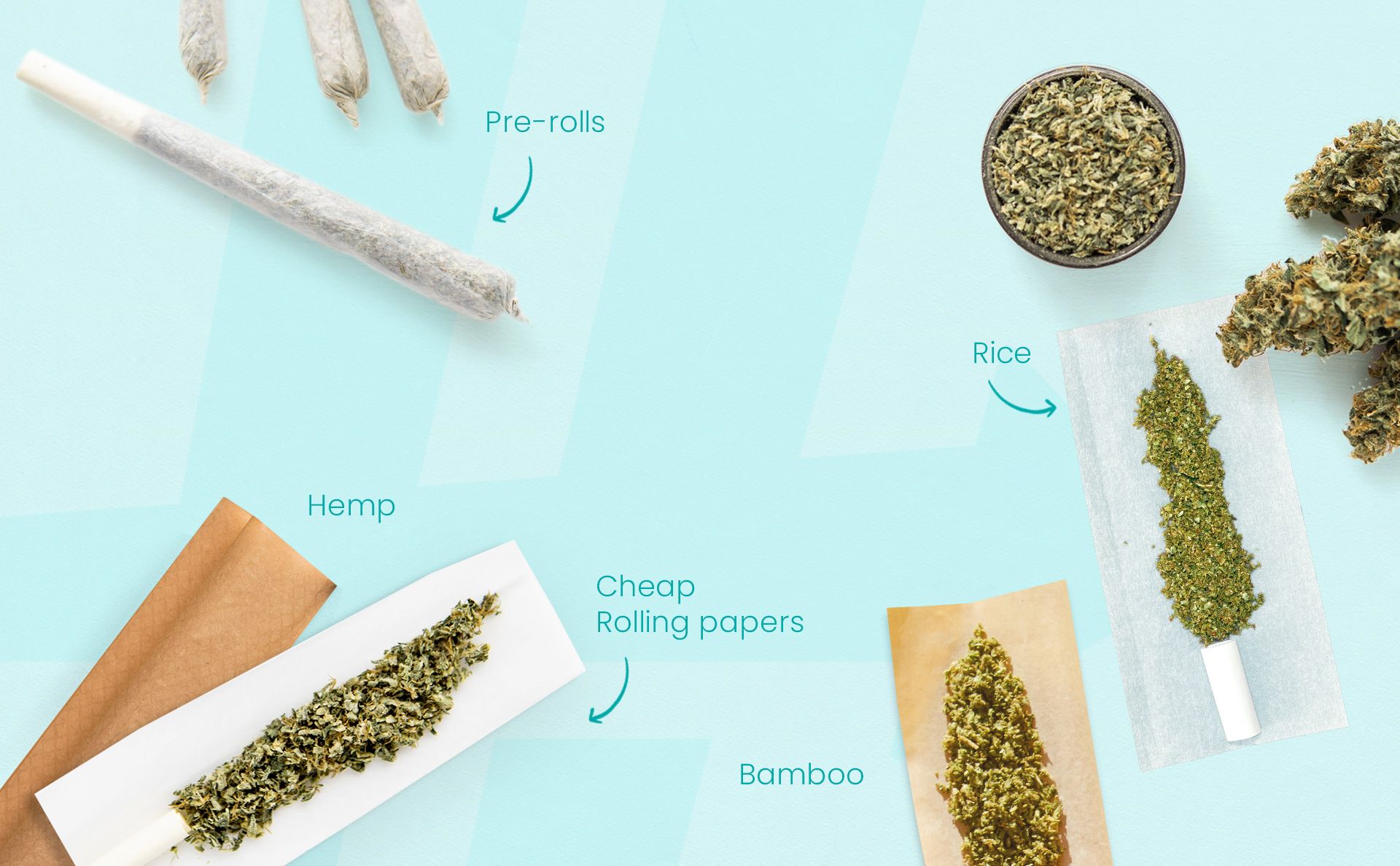Joints & Blunts
In this chapter, we cover what the canna-curious consumer needs to know about the classic ways to ingest the plant known as joints and blunts.

Combusting cannabis flower rolled in paper or leaves and inhaling the smoke is perhaps the oldest form of cannabis consumption. This method of consumption, often called smoking joints and blunts, remains among the most popular today. Rolling papers and blunt wraps are used to smoke cannabis by filling the paper with flower and rolling it up into something that resembles a cigarette.
While joints and blunts are primarily rolled with cannabis flower, experienced consumers may also mix in some concentrates on a joint or blunt. For in-depth coverage of all things Cannabis Concentrates, be sure to check out our corresponding guide.
What are Joints?
Joint smoking was popularized during the hippie generation of the 1960s, but they were fairly common before that as well. One large benefit of joints is that they are even more portable than handheld pipes. Additionally, the act of passing around a joint can be seen as a communal experience to enjoy with a group of friends.
Rolling paper can be made with a variety of starting materials including rice paper, rose petals, rice paper, and hemp. Because the paper is made from natural materials they are often eco-friendly, however, this is also why it is important to get quality papers (organic if possible) to ensure there are no residual chemicals or heavy metals in the paper you’re smoking- a quality cannabis experience goes all the way to the rolling paper used! Today, the market for cannabis joints is mainly focused on pre-rolls, or pre-rolled joints for sale in to-go tubes; this billion-dollar market will only continue to rise as legalization spreads.
Pre-rolled joints that you buy at dispensaries and retail locations come in all shapes, sizes, colors, and strengths. From the most elaborate, beautifully crafted joint wrapped in gold leaf pressed paper, to small quarter gram ‘dog walkers’ meant for a smaller tose, to the classic 1g doobie, there is no shortage of options to choose from when it comes to your pre-rolls.

There are also items called cones, which are cone-shaped, as the name implies, rather than the straight and narrow form of a standard joint. A cone is straight and thin at the bottom and becomes increasingly wider as it gets to the top. Most cones come with crutches or filters, which is a small piece of thick paper at the bottom, folded in a zig-zag orientation meant to prevent your cannabis flower from falling out of the bottom. The beauty of cones is if you don’t know how to roll a joint, you don’t have to. Simply take the cone, stuff it with flower, making sure to use a poker to ensure the flower is well packed and evenly distributed throughout the cone, then twist the top to finish!
What Are Blunts?
Most historians agree that cigars were first invented by the Ancient Mayans. These ancient people wrapped tobacco in leaves from trees, mainly palms or plantains to smoke. Archaeologists have discovered 10-century clay pots that depict images of Mayans smoking the first cigars.
One of the first American-made makers of fine cigars was called the Philadelphia Cigar Company, founded circa 1910. These fine cigars were nicknamed “Phillies” (no relation to the Philadelphia baseball team), and the brand eventually adopted the name. Today, the term “Phillie” is used to describe the hollowed-out wrapper of a Phillie blunt, filled with cannabis flower.
The outermost layer of a cigar, known as the wrapper or the leaf, is the most expensive part of the cigar. A blunt leaf will largely determine the quality of flavor and the smoothness and sweetness of its smoke. As such, a blunt's wrapper is used to roll cannabis.
The inner layer of the cigar wrapper is known as the binder, which contains thinner, more elastic leaves that help act as an adhesive and binding agent during the rolling process. The inside of a cigar is called the filler, which is the tobacco which is either tossed aside or mixed in with cannabis.
For cannabis smokers, flower is spread on blunt paper and smoked like a traditional cigar. Products called blunt wraps are also sold in tobacco smoke shops and gas stations, which are similar to joint paper, with the only difference being the blunt paper comes from tobacco and is typically much thicker compared to rolling papers for joints.
Because blunts come from tobacco leaves, they are more difficult to roll and potentially more harmful to your respiratory system. Smoking any nicotine products exposes the lungs to carcinogens that are not present in cannabis smoke alone. Blunt wraps are considerably more expensive than joint papers, blunts are longer and more girthy, and blunts don’t contain sticky gum to adhere the sides while rolling as rolling paper typically does. This all adds up to more skill being required to roll a blunt than a joint.

What the expert says...
Dr. Riley Kirk
"Most historians agree that cigars were first invented by the Ancient Mayans, who wrapped tobacco in leaves from nearby trees, mainly palms or plantains."
Always Use a Grinder
Lastly, it’s important to “break up” your cannabis flower before attempting to roll a joint or a blunt. If you choose to roll a joint and don’t have a grinder, it’s time to get one!
Many smoke shops sell affordable grinders. Using a grinder instead of our fingers to break up flower will make for a better smoke. This is because the oils on our skin can degrade the potency of cannabinoids, terpenes, and flavonoids of the cannabis flower.
When you’re preparing your flower for rolling, make sure to break apart the flower from the stem, and any seeds that may be present in your flower to ensure the flower will roll smoothly without lumps and bumps.
What We Learned: Joints & Blunts
Since flower is still the most popular cannabis product, it’s no surprise that smoking joints and blunts tends to also be the most popular – and perhaps the oldest way to consume. Here’s what we learned in this chapter:
- Joint smoking was popularized circa the hippie generation of the 1960s, but they were fairly common before that as well.
- Joints are even more portable than handheld pipes. Passing around a joint can be seen as a communal experience to enjoy with a group of friends.
- Eco-friendly rolling papers are made from plants like hemp, rice, and bamboo.
- Pre-rolled joints you buy at dispensaries and retail locations come in all shapes, sizes, colors, and potencies.
- Archaeologists have discovered 10-century clay pots that depict Mayas smoking the first cigars.
- The Philadelphia Cigar Company, founded circa 1910, made some of the first American cigars, known then as Phillies. Today, the term “Phillie” is used to describe the hollowed-out blunt wrapper, filled with cannabis flower.
- Because blunts come from tobacco leaves, they are both harder to roll and more harmful to your respiratory system.
- The oils on our skin can degrade the potency of cannabinoids, terpenes, and flavonoids of cannabis flower – so always use a grinder with your cannabis flower.
Even though some cannabis consumers view joints and blunts as old school, perhaps even antiquated, at HashDash, we appreciate the classics. Because while taking small doses of edibles may be safe for daily consumption, smoking anything every day is likely not so safe. For this reason, enjoying a joint or a blunt every once in a while can be a real treat for any cannabis lover.
Ready for the next chapter in this Guide? Answer the question below and let’s keep moving forward.
Citations
- Doukas, S.G., Vageli, D.P., Doukas, P.G., Nikitovic, D., Tsatsakis, A., Judson, B.L. (2022). The Effect of Tobacco Smoke N-Nitrosamines, NNK and NDEA, and Nicotine, on DNA Mismatch Repair Mechanism and miRNA Markers, in Hypopharyngeal Squamous Cell Carcin
- Way Back Machine: History of Cigarshttps://web.archive.org/web/20161107093854/http://finecigars.com.au/cigar-information/history-cigars-old-world/
- Lung.org: Health Effects of Cigarshttps://www.lung.org/quit-smoking/smoking-facts/health-effects/cigars#:~:text=Quit%20Smoking,-End%20the%20Epidemic&text=Cigar%20smoking%20can%20cause%20cancers,includes%20chronic%20bronchitis%20and%20emphysema.
Test your knowledge, track your progress and earn your badge.
What eco-friendly material are some joints made of?

Dr. Riley Kirk
Dr. Riley Kirk is a cannabis research scientist, educator, and advocate. She is passionate about making Cannabis science accessible to everyone through social media channels. The goal of Riley’s work is to unite people in the Cannabis industry, academia, and consumers to further the reach of Cannabis education and destigmatize plant medicine.